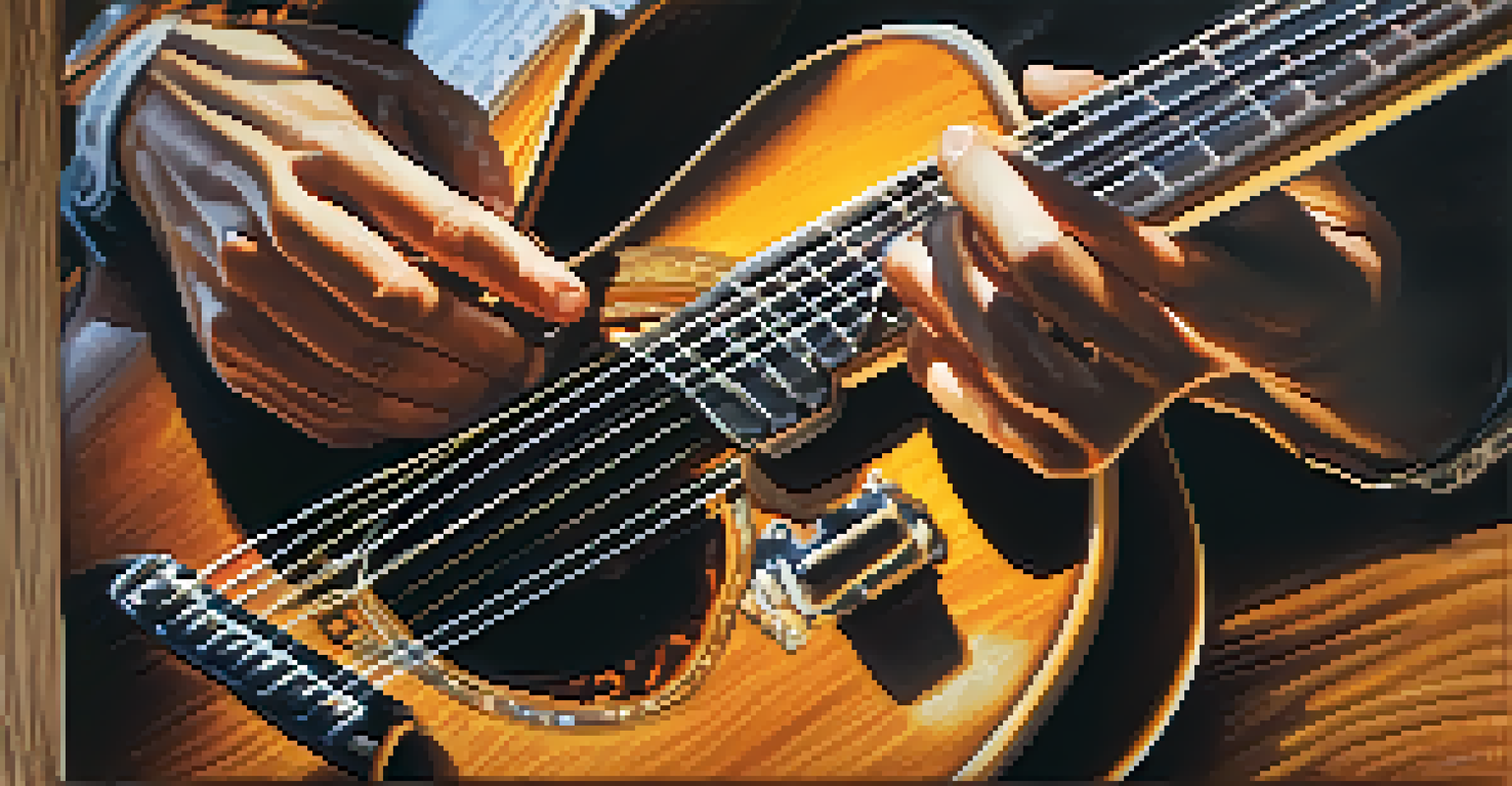Songwriting for Guitarists: Blending Artistry with Expression

Understanding the Basics of Song Structure
Every great song begins with a solid structure. Familiarizing yourself with common formats like verse-chorus-verse can help you lay a strong foundation. Think of song structure like a blueprint for a house; without it, you might end up with something that doesn’t quite stand up.
Music is the shorthand of emotion.
A typical song structure often includes an intro, verses, chorus, and a bridge. Each part serves a unique purpose, building the narrative and emotional journey of the song. Just like a good story, your song should have a beginning, middle, and end to keep listeners engaged.
Experimenting with different structures can yield fascinating results. Try swapping the order of verses or adding an unexpected bridge to surprise your audience. This playful exploration is where creativity flourishes and your artistry shines.
Finding Your Unique Voice and Style
As a guitarist, developing a unique voice is crucial in distinguishing yourself from others. This voice can be influenced by your favorite genres, artists, and personal experiences. Think of your voice as your fingerprint—no one else has it, and it makes your music authentically yours.

To discover your style, take time to experiment with different techniques, tunings, and melodies. Spend a few hours jamming in various genres, whether it's blues, rock, or folk, and see what resonates with you. Sometimes, the best ideas come from unexpected places.
Song Structure is Essential
Understanding common song formats like verse-chorus-verse helps create a solid foundation for engaging music.
Don’t be afraid to embrace your influences while also forging your path. Combine elements from different genres, and let your emotions guide your songwriting process. This blend of inspiration and personal expression can lead to truly original compositions.
The Importance of Lyrics in Songwriting
Lyrics play a vital role in conveying the emotion and message behind your music. They can tell stories, evoke feelings, or even inspire action. Think of lyrics as the heart of your song, giving it meaning and depth that resonates with listeners.
The best way to predict the future is to create it.
When writing lyrics, consider your experiences and feelings as a source of inspiration. Reflect on moments that have shaped you, whether joyful or challenging, and weave these themes into your words. This personal touch can create a powerful connection with your audience.
Don’t shy away from using imagery and metaphors to enhance your lyrics. Descriptive language can paint vivid pictures in the minds of your listeners, making your song memorable. For example, saying 'the sun sets like a golden coin' creates a striking visual that lingers long after the song ends.
Creating Compelling Melodies with Guitar
Melody is the soul of a song, and as a guitarist, you have the power to create captivating tunes. Start by playing around with scales and chords, allowing your fingers to guide you to unexpected notes. Sometimes, the most enchanting melodies emerge from spontaneous playing.
Consider using techniques like palm muting or harmonics to add texture to your melodies. These techniques can transform simple chord progressions into something magical, enriching your overall sound. Think of it as decorating a cake; the icing makes all the difference!
Lyrics Convey Emotion and Meaning
Well-crafted lyrics can tell powerful stories and create a deep connection with listeners.
Don’t hesitate to record your ideas as they come. Whether it’s a catchy riff or a beautiful chord progression, having a library of melodies to draw from can be invaluable. You never know when inspiration might strike, so capturing those fleeting moments will serve you well in your songwriting journey.
Harmonizing with Chords and Progressions
Chords form the backbone of your song, providing harmony and depth to your melodies. Understanding how different chord progressions work can drastically enhance your songwriting. Just like a painter chooses colors to create a mood, your chord choices set the emotional tone of your music.
Experimenting with various progressions can lead to surprising and unique results. Try combining major and minor chords to evoke contrasting emotions, or delve into jazz chords for a sophisticated feel. This exploration can lead you to discover new sounds that resonate with your artistic vision.
Remember that the simplest chord progressions can often be the most effective. Many hit songs rely on basic patterns, proving that complexity isn’t always necessary for beauty. Focus on creating a strong foundation, and let your melody take flight from there.
Incorporating Dynamics and Techniques
Dynamics in music refer to the variations in loudness and intensity, and mastering them can elevate your songwriting. Playing softly during verses and building to a powerful chorus can create an emotional rollercoaster for your listeners. Think of dynamics as the ebb and flow of ocean waves, bringing life to your song.
Incorporating techniques like fingerpicking, strumming patterns, and slides can add richness to your sound. Each technique brings a different flavor, much like spices in cooking. Experiment to find what complements your song best.
Collaboration Enhances Creativity
Working with other musicians can introduce new perspectives, enriching your songwriting process.
Don’t forget the importance of silence as well. Pauses can create tension or anticipation, allowing your audience to absorb what they’ve just heard. A well-placed silence can be just as powerful as a strong chord, making your composition more impactful.
Collaborating with Other Musicians
Collaboration can breathe new life into your songwriting process. Working with other musicians allows you to share ideas, techniques, and perspectives that you might not consider alone. It’s like opening a door to a new room filled with inspiration and creativity.
When collaborating, be open to feedback and suggestions. Different viewpoints can enhance your work and push you to explore uncharted territories in your music. Remember, every musician brings their unique strengths, so embrace this diversity.

Whether you’re jamming with friends or co-writing with a seasoned artist, collaboration can lead to exciting outcomes. Some of the best songs in history were born from partnerships, proving that the magic of music often lies in unity.
The Art of Refining Your Song
Once you've crafted your song, the refining process is essential to bring out its full potential. This stage involves reviewing your lyrics, melody, and structure, making adjustments that enhance the overall impact. Think of it as polishing a diamond; the more you refine it, the more it sparkles.
Consider seeking feedback from trusted friends or fellow musicians. Fresh ears can catch things you might have missed and offer valuable insights. Be open to constructive criticism; it’s a tool for growth and improvement.
Finally, don’t rush the process. Great songs take time to develop, so give yourself the space to explore and edit. Embrace the journey of songwriting, and remember that every iteration brings you closer to a piece of art that truly represents you.